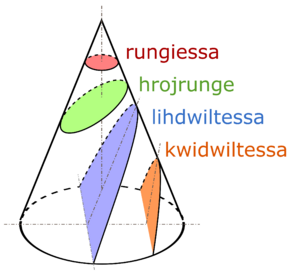runge: Difference between revisions
Jump to navigation
Jump to search
m (Reformatted {{Etymology}} with language code (lfv)) |
m (Removed redundant {{Etymology}} template) |
||
| Line 1: | Line 1: | ||
== Laefevian == | == Laefevian == | ||
[[File:Conic Sections LAEF.png|thumb|Conic sections in Laefevian.]] | [[File:Conic Sections LAEF.png|thumb|Conic sections in Laefevian.]] | ||
=== | === Etymology === | ||
{{root|lfv|lnk-pro|ʔam-}} | {{root|lfv|lnk-pro|ʔam-}} | ||
{{root|lfv|lfv|rung-}} | {{root|lfv|lfv|rung-}} | ||
Latest revision as of 15:47, 20 August 2024
Laefevian
Etymology
From Proto-Laenkean *ri(n)ʔm̥kʼés (“something curved, circle”).
Pronunciation
Noun
runge (nominative dual rungend, nominative plural rungir)
Declension
| ExpandPrimary case declension of runge (see Laefevian declension) |
|---|
| ExpandSecondary case declension of runge (see Laefevian declension) |
|---|
Derived terms
Translations
Showcircle
See also
- hnwalketessa (“conic section”)
- kwidwiltessa (“hyperbola”)
- lihdwiltessa (“parabola”)
Categories:
- Laefevian terms derived from the Proto-Laenkean root *ʔam-
- Laefevian terms belonging to the root rung-
- Laefevian terms inherited from Proto-Laenkean
- Laefevian lemmas
- Laefevian nouns
- lfv:Geometry
- lfv:Mathematics
- Laefevian terms without usage examples
- Laefevian light e-stem nouns
- Laefevian terms missing an inflection table
- Laefevian terms with Radestrian translations
- Laefevian terms with translations
- Terms needing Riyan translations
